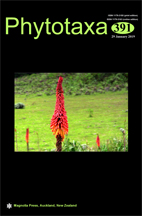Abstract
Amphisphaeria flava and A. thailandica sp. nov. collected from dead woody branches in northern Thailand, are described and illustrated in this study. Both taxa share ascomata with a brown outer peridium and 1-septate brown ascospores in uniseriate asci. Amphisphaeria flava is characterized by a pale yellow host surface around the ostiole, a comparatively thin peridium and multi-guttulate mature ascospores. Amphisphaeria thailandica is characterized by subglobose to oval ascospores. Maximum parsimony, maximum likelihood and Bayesian inference analyses of a combined LSU and ITS DNA sequence matrix shows that A. flava and A. thailandica are distinct from other Amphisphaeria species (with molecular data available) in family Amphisphaeriaceae. A key to accepted Amphisphaeria species is provided.

